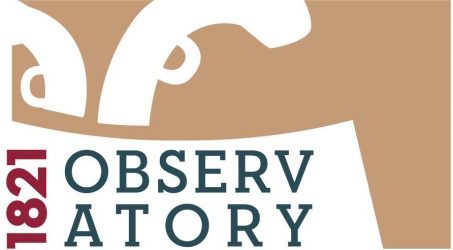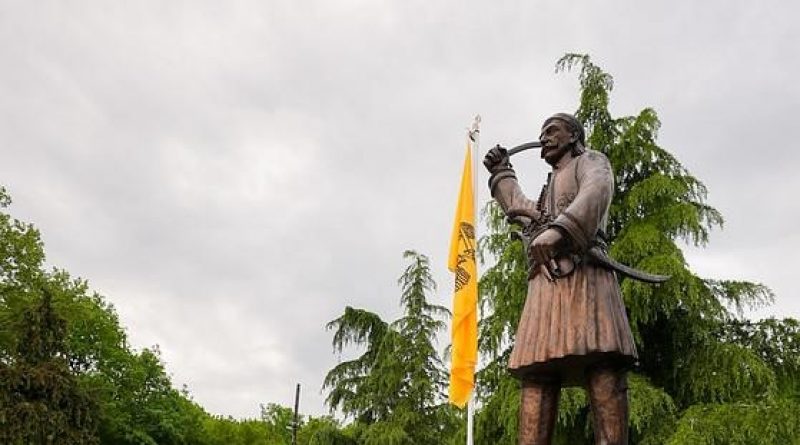Unknown chieftains of the Greek Revolution: Tassos Karatasos
The revolutionary activity in Macedonia began in March 1821, with the arrival on Mount Athos of the Serres merchant and Philiki Etaireia member Emmanouil Pappas. The previous month, the Etaireia had appointed him “leader” of the revolution in Halkidiki. With the support of Mount Athos, he managed to incite the subjected population throughout Sithonia and to reach the outskirts of Thessaloniki.[1]
Soon, in addition to Halkidiki, two more revolutionary centres were organised in Macedonia: one on Mount Olympus and one in Naoussa.[2] In addition, all the chiefs of Macedonia unanimously decided to support Pappas’ revolution in Halkidiki, calling for a general uprising of all the subjected inhabitants of the region.[3]
Very soon the revolutionary activity in Halkidiki was suppressed by the troops of the Ottoman Pasha Ebulubud Mehmed Emin, who in his attempt to suppress any similar activity in Macedonia, ordered, on the one hand, the arming of all Ottoman troops in the region and, on the other, the disarming of the Christian inhabitants of Veria and Naoussa. In addition, he demanded that the eldest sons of prominent families in the cities and towns of Macedonia to be presented as hostages. They would be held captive in the prisons of Thessaloniki.[4] All the cities obeyed, with the exception of Naoussa, after a prominent chief, Zafeirakis Logothetis, refused to send his son hostage to Thessaloniki.[5]
Zafeirakis’ refusal was supported by the other two Naoussan chiefs, Tassos Karatasos and Angelis Gatsos, who in April 1821 raised the banner of the revolution in the metropolitan church of Agios Dimitrios, calling for a general uprising in the area. Karatasos was appointed leader of military operations in Naoussa and the wider Veria area.[6] This fact angered the pasha, who decided on exemplary punishment for the rebels.
The military operations in the area, however, were characterised by a lack of organisation and coordination. For this reason they lasted only one year, from April 1821 to April 1822.[7] Thus, in the battle of Milia, Naoussa, on 4 April 1822, despite the heroic efforts of Karatasos to defend the city, Naoussa, the centre of military activity in Macedonia, was occupied by Ottoman troops as were, within just 10 days, the villages and monasteries of the area.[8]
After the catastrophe, many women and children were taken to the slave markets in the East or taken captive and tortured in a brutal way to make them convert, which often ended in death. Among the dead were the woman and five of Karatasos’ six children.[9] However, he and the 2,000 rebels who followed him managed to escape and find refuge on the island of Skiathos, where 20,000 inhabitants of the wider region of Macedonia had also taken refuge.[10]
From Skiathos, Karatasos went to the area of southern Greece under revolt and until 1828 offered his services in Messolongi, Halkida and the Peloponnese.[11] He died on 22 January 1830, having received the military rank of lieutenant.[12]
To mark Karatasos’ contribution to the Greek Revolution, the Municipality of Naoussa, in a simple ceremony that took place on 23 March 2014 in his birthplace of Dichalevri, part of the Stenimachos, Naoussa, unveiled a statue to him which was executed by the artist Nikos Konstantinidis.[13] Also, the Diocese of Veria, Naoussa and Kampania, within the framework of the events of the Church of Greece to mark the bicentenary of the Greek Revolution, honoured the Naoussa chieftain with a dedicated, online talk on 27 July 2021.[14]
, PhD Candidate, Department of History and Ethnology Democritus University of Thrace
[1] For more on the revolutionary activity in the region of Halkidiki, see Giorgos Georgis, “Μακεδόνες αιχμάλωτοι των Οθωμανών” [Macedonian prisoners of the Ottomans] (talk presented to the international scientific conference Macedonia in the Revolution of 1821: Political, Social, Economic and Historical Dimensions, Society for Macedonian Studies, Thessaloniki, 12-14 February 2021), https://youtu.be/uL4CBZnDLPU?t=310). All papers presented at the conference will be published by the Society for Macedonian Studies.
[2] Georgis, “Μακεδόνες αιχμάλωτοι.”
[3] Giorgios Chionidis, “Ανέκδοτα έγγραφα και άγνωστα στοιχεία για κλεφταρματωλούς και για την Επανάσταση (1821-1822) στη Μακεδονία και ιδιαίτερα στον Όλυμπο” [Unpublished documents and unknown facts about kleftarmatolos and about the Revolution (1821–1822) in Macedonia and especially on Olympos], Makedonika 20 (1980): 103–66.
[4] Panos Maniatopoulos, Η Επανάσταση στη Νάουσα το 1822 και το ολοκαύτωμα της ηρωικής πόλης [The revolution in Naoussa in 1822 and the holocaust of the heroic city] (self-pub., 2022) Open Library, https://www.openbook.gr/i-epanastasi-sti-naoysa-to-1822/.
[5] Georgis, “Macedonian prisoners.”
[6] Tassos Karatasos was born in 1764 in Dichalevri, Naoussa. During the pre-revolutionary period he was a kleftarmatolos in the armatoliki of Naoussa and according to the testimony of his only surviving son (after the destruction of Naoussa in 1822), Tsamis Karatasou, “was the fear of the force (of the Turks) and sent thousands of them to their graves and for 40 years he extended his sovereignty over three provinces, Veria, Giannitsa and Vardar… and for 40 years they (the pashas of the region) recognised this chief undisturbed.” Upon the outbreak of the Revolution, Karatasos donated his property to the armed preparation of the struggle. For more on the life and work of Karatasos, see Giorgios Chionidis, “Σχεδίασμα περί του γερο-Καρατάσου και της οικογενείας του” [A sketch of the old man Karatasos and his family], Makedonika 9 (1969): 295–316.
[7] Georgis, “Macedonian prisoners.” According to Georgis, the operations in the region of Macedonia lasted only a year, but were of great importance, as during this period, the revolutionary armed forces prevented the Ottoman forces from advancing from the north to southern Greece. This event resulted in the organisation and consolidation of the revolution in the Peloponnese.
[8] Giorgios Chionidis, “Νέα στοιχεία για τη χρονολόγηση του ‘χαλασμού’ της Νάουσας και των μοναστηριών στα 1822” [New data for the dating of the ‘ruin’ of Naoussa and the monasteries in 1822], Makedonika 21 (1981): 155–67. After the destruction of Naoussa, all revolutionary activities in Macedonia halted permanently.
[9] Chionidis, “Σχεδίασμα.”
[10] Chionidis, “Ανέκδοτα έγγραφα.”
[11] Chionidis, “Σχεδίασμα.”
[12] Giorgios Chionidis, “Οι εις τα Μητρώα των Αγωνιστών του 1821 αναγραφόμενοι Μακεδόνες” [The Macedonians listed in the registers of the 1821 fighters], Makedonika 12 (1972): 34–65. According to these registers, Karatasos was one of the 103 Macedonian officer fighters.
[13] The unveiling ceremony was attended by the Mayor of Naoussa, Dimitrius Karabatzos, the Metropolitan of Veria and Naoussa, Panteleimon, the president of the community of Stenimachos, Chr. Alpatzis, and residents and representatives of local associations. For more on the unveiling, see Makis Dimitrakis, “Ο Γερο-Καρατάσος: Η ζωή του, η μάχη του στη Δοβρά, με την ευκαιρία της 200ης επετείου της Ελληνικής Επανάστασης” [Gero-Karatasos: His life, his battle in Dovra, on the occasion of the bicentenary of the Greek Revolution], Laos News, 25 Mar 2021, https://www.laosnews.gr/article/94207-o-gero-karatasos-h-zoh-tou-h-maxh-tou-sth-dobra-me-thn.
[14] The talk, the 11th organised in the diocesan series, was entitled “Ο Μακεδών ήρωας Τάσος Καρατάσος” [The Macedonian hero Tassos Karatasos], https://youtu.be/niTdBH8Fc6g.

